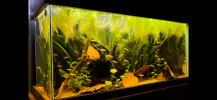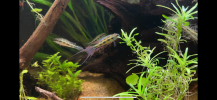Jasonmc89
New Member
- Messages
- 23
First do some pure RO waterchanges to get the last bit of hardness out (may take a few extra waterchanges extra as wood and substrate are soaked with the water as it is right now, you will have to passively flush them.).
Little disclaimer: Peat can not sustainably sourced and thus helps destroying priceless habitats.
Botanicals (autmn leaves, alder cones, organic rooibos) are a sustainable alternative, but they take much more time but little effort. You have time, so consider it.
It is available in garden centers in big bags for cheap, just look for peat without vertilizers.
It is also available in small overprized packages in the aquarium trade (e.g. by Eheim).
For some reason it is also sold as peat moss, which is an misnomer and can get you actual, still green or dried sphagnum moss. That doesn't do the trick.
There are mesh bags for filter media available, nylon panties are the cheap DIY alternative. Fill one or two of these bags with peat so it is about the size of your fist. Water it overnight so it can soak, then either out it in the second to last stage of a canister filter or alternatively just add them to the tank, somewhere where they get some waterflow.
Check the parameters for some days.
One more heads up to that:
pH-meters and driptests (let alone strips) do not work properly in softwater, so if you want to know what pH you are getting out of it, take a sample add some table salt (NaCl) to raise conductivity without changing pH and measure with a meter.
About the dangers:
Be aware, it is hard to get the pH below 6 as it takes lots of H+ ions. A pH-crash is almost impossible to trigger with peat or botanicals. It is more likely to cause an oxygen depletion, but for this you'd have to add so much peat or botanicals at once, it is unlikely to happen. Luckily a simple airstone can solve the problem within hours and an emergency waterchange if necessary, too. But the likelhood is very very low.
Just to have told you:
Alternatively add the following mixtur once a week over 3 months.
- 2 Liters of RO
- 20 alder cones
- 4-5 whole cattapa leaves or 10-15 beech or oak leaves
- 2 teabags of organic rooibos without aroma additives
Bring the water to a boil, add the botanicals let it cool down and steep for at least 4 hours or overnight, add the brew to the tank, as well as the leaves. The cones can be dried and used up to 3 times. The leaves should stay in the tank until completely desintegrated.
Just for reference this is how my tank looks

